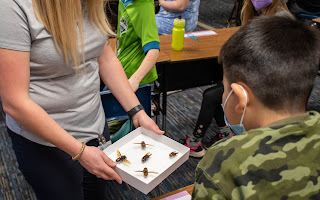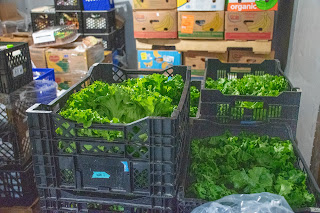Karla Salp
Communications
 |
| A student examines a hornet larva |
From the start, an important part of WSDA’s approach to
ridding the state of this invasive pest has been public education and
involvement, which is what brought outreach specialist Cassie Cichorz to visit
a third-grade class at Skyline Elementary in Ferndale last Tuesday.
With a wagon full of hornet memorabilia, Cassie has been
visiting classrooms around Whatcom County, bringing the hornet to children
class by class. Her impressive collection includes hornets in various life
stages, combs from nests, a hornet suit she uses during nest eradication, posters,
and – always popular with the students – Asian giant hornet temporary tattoos.
 |
| Students giving a thumbs-up for their favorite Asian giant hornet life stage |
Winter is the perfect time for Cassie’s classroom visits – it is a break from our fieldwork that coincides nicely with school schedules – especially those in areas most likely to encounter the world’s largest hornet.
 |
| Cassie Cichorz calls on a student in the back of the class while displaying hornets |
Cassie spent half an hour with the class. While telling them
about the hornets, she passed around vials containing hornets at various life
stages. Some of the students displayed an impressive knowledge of insect
development, naming all of the life insect stages: egg, larva, pupa, and adult.
She also carried around a piece of comb from one of the
nests that WSDA eradicated just a few miles from the school. The nest comb was “look
but don’t touch” because of how delicate the paper comb is.
 |
| A student looks at pinned hornet specimens |
Both students and staff were fascinated by the insects and most are excited about the opportunity to see them up close. One little girl was too excited to stay in her seat and kept sneaking up close to Cassie to better see the specimens she had even before they were passed around the room. And one staff member confessed that teachers who had already hosted Cassie in and her wagon of wonders in their rooms were sure to take a selfie with a hornet.
 |
| Cassie Cichorz lets students feel her hornet suit |
While most students love the presentation, not everyone is so enthusiastic.
“Thanks, I’ll never sleep again,” one student said as Cassie
packed up her wagon to head to the next classroom.
Schools in Whatcom
County interested in the presentations can contact
Cassie. She isn’t able to visit every school in the state, but there are
many Asian
giant hornet resources on our website, including math and science lesson
plans appropriate for grades 6 – 10 from Scholastic.






